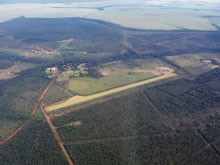- Target: 100% renewable energy
- Status: Achieved
- RES: Solar panels, wind turbines and a water pump.
- Implementation: In 1971, Paolo Lugari, a development specialist, brought together a group of scientists, artists, and former street kids to see if they could create a sustainable village in the middle of the uninhabited eastern plains of Llanos Colombia. This region at the time was so remote and so poor in soil quality, untouched even by the country's political upheavals. Lugari wanted to prove that his ecological village model would be possible anywhere. The group set out through experiments and innovations, to create Las Gaviatos: a thriving ecosystem and eco-village of 200 people. The village since then has resisted drug wars and violence. Today, there are no guns, no police force, no cars, no mayor, no church, no priest, no cellphones, no television, no Internet. However, Gaviotas has created a range of innovations intended to make human life feasible in one of the most challenging ecosystems. It sources its energy from a variety of renewable energy installations, including solar panels and wind turbines. It has created a solar kettle for sterilising water, a solar kitchen, and a water pump powered by children on a seesaw. The community also grows their own food and have seen a return of wildlife that had not inhabited the area for many generations. In the 1990s, the villagers began exporting resin sourced from pine trees. Part of a 19,800-acre reforestation project, the resin is used for biofuel in the community's tractors and motorbikes, or processed for market sale to use in products like varnishes and linseed oil. The trees have also provided a vital canopy for native plant species to flourish under.
- Population: 200 inhabitants
- Area: 8,000 hectares (first phase reforestation)
- Link: CENTRO LAS GAVIOTAS

- In Spanish